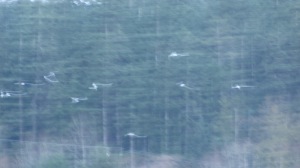
Soundwalk
Journal Entry, February 1992, Ness Lake, BC
“Our sound environment is the skin of ice on the lake creaking and snapping in the dusk air, distant sighs of truck engines moving across the sonic horizon across the bay, small puffs of snow falling from tree branches. It is faraway coyote yip-whine-howling, the chorus of responding dog bark-howls panning the lake’s periphery, circling back to end in a silence of attentive anticipation. The sharp crack of firewood being chopped, the echoes bouncing off stands of nearby trees.
As we go back up the hill toward the house, I am aware of the loudness of my footsteps crunching through the snow and my now heavier breathing in rhythm with them. My daughter, content inside the rocking motion of being carried inside my parka against my body. The always present intimacy of our breaths, the rhythm of inhale exhale reinforced by the gentle steam she might feel on her face as my air joins with hers …
Coming into the house, the tangible sensation of sonic sharpness we experienced outside is suddenly muffled. The sound of the refrigerator motor momentarily tenses my body. I wonder if my daughter feels this response and in turn will learn to turn on her own tension around appliance sound. Then I remember my regular loud chanting that blends with the rich harmonic drone of the vacuum motor and short wild voicings in duet with the coffee grinder in the morning. Perhaps there is a balance.
The phone rings, the fire crackles and snaps.”
I realized a few years after this entry, while visiting in the less hi-fi soundscape of the sparkling city of Vancouver, that I had learned to sense much of my daughter’s needs and states by listening to her. If I were to describe the sonic environment that we shared at home in the North, I would mention the way the wind sounds different depending on its direction, its speed, the trees it is blowing through. Or the snow in winter blanketing the vegetation, rocks, leaves, creating such quiet that on a calm day we could hear a a crow calling from half a mile across the lake, a dog barking from much further. Or I would mention the sonic differences of the seasons, the interactions of their flora, fauna, insects, elements. We were outside much, and when inside, the quiet of the house was intimate, with awareness of the the outer sounds present even when not heard.
My daughter’s soundings – the rhythm and frequency spectrums of her breath and voice, the weight, flow and pace of her movements, the tone of her murmurs, the intensity, texture, colour of her cries, the quality of her responses to the sounds around us – gave me detailed and nuanced information that became a rich manual that deeply guided me in mothering.
This experience in turn brought me to a new intimacy with sound and honed my listening skills in ways I had not imagined possible. Already an intentional soundscape and inner listener, this new listening with my newborn daughter, imagining what she perceived from her new ears perspective, sharpened my experience of sonic detail in near and far, inner and outer sound, imagined sound, sonic memory.
While walking with my daughter, now three, on a sidewalk in a Vancouver neighbourhood, I felt alienated from her, distant. I realized that I could not hear her. I could not hear the rhythm of her footsteps, the depth or quality of her breath. Even in this lovely treed neighbourhood where I could hear nearby birds and crows, the sense of sonic intimacy with my daughter, an intimacy that I had learned to rely on, was diminished.
So we learned to adapt when we were in the city. Whispered head to head stories, humming and singing, more eye contact, more physical closeness. And expanded again when we returned home.
–Tina Pearson, 1995